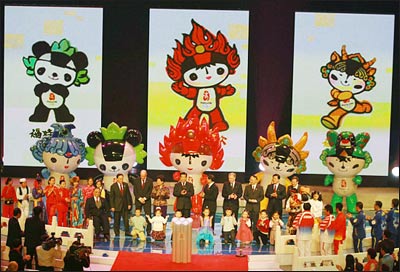In the early 20th century, to become a member of the Olympic
family was only a dream for the Chinese. Before the People's
Republic of China was founded in 1949, Chinese athletes had
participated in three Olympic Games but had returned empty-handed.
Since 1949, China has participated in six summer and eight winter
Olympics, winning 112 gold medals in summer Olympics. At the Los
Angeles, Barcelona and Atlanta Olympics, China came fourth in the
gold medals table, and second at the Athens Olympics.
In 1979 China resumed its legitimate membership of the
International Olympic Committee (IOC). In 1981 He Zhenliang was
elected an IOC member, marking a new period in the relations
between China and the Olympics. From then on, Chinese sports
circles started to popularize and promote the Olympics. An
important part of their work was to have the Chinese people,
representing one fifth of the world's population, share the honor
and joy of hosting the Olympic Games, thus reflecting the Olympic
principle of inclusivity. In July 2001, Beijing finally succeeded
in its bid to bring the 2008 Olympic Games to its ancient capital
with a history of 3,000 years.
The Beijing Olympic Organizing Committee (BOOC), established at
the end of 2001, set the themes for the 2008 Games as "Green
Olympics," "High-tech Olympics" and "Humanistic Olympics." Since
2003, 30 Olympic venues have been started, following public bidding
for their design and construction. Seven venues, including the
National Stadium and the National Swimming Center, are of exquisite
and ingenuous design, ushering in a new period of poetic
architecture for Beijing. The centerpiece of the 2008 Games will be
the "Birds Nest" National Stadium. With a capacity of 100,000
spectators, the stadium will host the opening and closing
ceremonies as well as track-and-field events.
According to the budget released by BOOC in September 2003,
construction of the venues will cost about US$2 billion and the
financing system framework has been determined. Beijing will spend
180 billion yuan on infrastructure construction, much of the
expenditure devoted to 142 large-scale projects including
high-speed transportation networks, environmental improvements and
creation of information systems. Another plan is to exploit the
experience of preparing and hosting the 2008 Olympics to make
Beijing into an international center for sport.
 |
On November 11, 2005, the official mascots of the Beijing
Olympics made their debut. The mascots consist of five "Fuwa" lucky
dolls, namely Beibei, Jingjing, Huanhuan, Yingying and Nini, whose
individual names link to sound like the expression "Beijing
huanying ni" (welcome to Beijing). Their shapes resemble those of
the Olympic flame, the panda, the Tibetan antelope, swallow and
fish respectively, and each one takes a different color of the
Olympic Rings ? red, orange, blue, green and black.